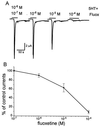Blockage of 5HT2C serotonin receptors by fluoxetine (Prozac)
- PMID: 9050900
- PMCID: PMC20038
- DOI: 10.1073/pnas.94.5.2036
Blockage of 5HT2C serotonin receptors by fluoxetine (Prozac)
Abstract
Fluoxetine (Prozac) inhibited the membrane currents elicited by serotonin (5-hydroxytryptamine; 5HT) in Xenopus oocytes expressing either cloned 5HT2C receptors or 5HT receptors encoded by rat cortex mRNA. Responses of 5HT2C receptors, elicited by nM concentrations of 5HT, were rapidly and reversibly blocked by micromolar concentrations of fluoxetine. For responses elicited by 1 microM 5HT, the IC50 of fluoxetine inhibition was approximately 20 microM. In accord with the electrophysiological results, fluoxetine inhibited the binding of [3H]5HT to 5HT2C receptors expressed in HeLa cells (Ki approximately 65-97 nM), and the binding to 5HT receptors in rat cortex membranes was also inhibited but less efficiently (Ki approximately 56 microM). Our results show that fluoxetine is a competitive and reversible antagonist of 5HT2C receptors and suggest that some therapeutic effects of fluoxetine may involve blockage of 5HT receptors, in addition to its known blockage of 5HT transporters. Similar work may help to design more selective compounds for use in the treatment of brain disorders.
Figures







Similar articles
-
Irreversible antagonism of 5HT2c receptors by N-ethoxycarbonyl-2-ethoxy-1,2-dihydroquinoline (EEDQ).Proc Natl Acad Sci U S A. 1997 Mar 18;94(6):2715-8. doi: 10.1073/pnas.94.6.2715. Proc Natl Acad Sci U S A. 1997. PMID: 9122262 Free PMC article.
-
Antidepressant- and cocaine-sensitive human serotonin transporter: molecular cloning, expression, and chromosomal localization.Proc Natl Acad Sci U S A. 1993 Mar 15;90(6):2542-6. doi: 10.1073/pnas.90.6.2542. Proc Natl Acad Sci U S A. 1993. PMID: 7681602 Free PMC article.
-
Differential regulation of corticosteroid receptors by monoamine neurotransmitters and antidepressant drugs in primary hippocampal culture.Neuroscience. 2003;118(4):975-84. doi: 10.1016/s0306-4522(03)00038-1. Neuroscience. 2003. PMID: 12732243
-
Understanding the molecular pharmacology of the serotonergic system: using fluoxetine as a model.J Pharm Pharmacol. 2012 Mar;64(3):317-25. doi: 10.1111/j.2042-7158.2011.01384.x. Epub 2011 Nov 18. J Pharm Pharmacol. 2012. PMID: 22309263 Review.
-
Fluoxetine pharmacogenetics in child and adult populations.Eur Child Adolesc Psychiatry. 2012 Nov;21(11):599-610. doi: 10.1007/s00787-012-0305-6. Epub 2012 Jul 12. Eur Child Adolesc Psychiatry. 2012. PMID: 22791347 Review.
Cited by
-
Effects of fluoxetine and d-fenfluramine on cocaine-seeking behavior in rats.Psychopharmacology (Berl). 2003 Jul;168(1-2):146-154. doi: 10.1007/s00213-002-1307-8. Epub 2003 Jan 16. Psychopharmacology (Berl). 2003. PMID: 12529808
-
First Evidence of Kv3.1b Potassium Channel Subtype Expression during Neuronal Serotonergic 1C11 Cell Line Development.Int J Mol Sci. 2020 Sep 29;21(19):7175. doi: 10.3390/ijms21197175. Int J Mol Sci. 2020. PMID: 33003279 Free PMC article.
-
Inhibition of G protein-activated inwardly rectifying K+ channels by different classes of antidepressants.PLoS One. 2011;6(12):e28208. doi: 10.1371/journal.pone.0028208. Epub 2011 Dec 2. PLoS One. 2011. PMID: 22164246 Free PMC article.
-
Microdosing ketamine in Drosophila does not inhibit SERT like SSRIs, but causes behavioral changes mediated by glutamate and serotonin receptors.bioRxiv [Preprint]. 2023 Nov 8:2023.11.07.566121. doi: 10.1101/2023.11.07.566121. bioRxiv. 2023. Update in: J Neurochem. 2024 Jun;168(6):1097-1112. doi: 10.1111/jnc.16070. PMID: 37986873 Free PMC article. Updated. Preprint.
-
Neural regulation of the contractility of nutrient artery in the guinea pig tibia.Pflugers Arch. 2020 Apr;472(4):481-494. doi: 10.1007/s00424-020-02362-9. Epub 2020 Mar 24. Pflugers Arch. 2020. PMID: 32211976
References
-
- Cusack B, Nelson A, Richelson E. Psychopharmacology (Berlin) 1994;114:559–565. - PubMed
-
- Wong D T, Bymaster F P, Engleman E A. Life Sci. 1995;57:411–441. - PubMed
-
- Wong D T, Threlkeld P G, Robertson D W. Neuropsychopharmacology. 1991;5:43–47. - PubMed
-
- Chen Y, Peng L, Zhang X, Stolzenburg J U, Hertz L. Brain Res Bull. 1995;38:153–159. - PubMed
-
- Fan P. Neuroscience. 1994;62:515–522. - PubMed
Publication types
MeSH terms
Substances
Grants and funding
LinkOut - more resources
Full Text Sources
Other Literature Sources

